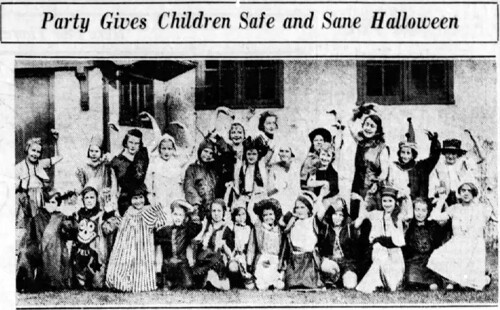How The Potato Famine And The Great Depression Gave Birth To Haunted Houses, Trick Or Treating, And Halloween

The potato famine isn't really what you think of when you think of Halloween, but when the Irish came over to escape it, that's exactly what they brought with them -- a time for pranks, fun activities, and destruction of property. Why are both Irish holidays exclusively about mass destruction? Is it just payback for all the discrimination?
It wasn't just schoolyard pranks either; Halloween got wild. In 1879, a train in Kentucky was stopped by a fake body laying across the railroad tracks, while a couple of years later, med students at the University of Michigan stole a headless corpse from the lab and put it against their building's front doors. In the 1930s, a girl almost lost an arm, and a man was nearly blinded in Halloween-related stonings. This kind of Purge-like attitude towards Halloween was accepted because children are evil, and concentrating it all on one day seemed to help. But then the Great Depression came, and with it, absolutely no room for tomfoolery at all whatsoever.

During one notorious day known as Black Halloween, people realized something needed to be done after millions of dollars of property damage. Cars were being turned over, there was chaos in the streets, and this was during an era when suicide was the second most popular pastime, right after dying of treatable diseases and poverty (tied for first).
Don't Miss
So what was the solution? Take all of that restless energy, and turn it into fear.
However, in an attempt to get these kids to stop destroying everything, they treated "trails of terror." They started small; you'd walk through different houses in the neighborhood where spooky things await. The earliest ones had "weird moans ... damp sponges..." and most excellently "Tige," who is a guard dressed as a dog, suddenly ... barking and growling." This was also when trick or treating became a common activity -- as a way to get the kids to do literally anything to keep them from wrecking everything.

The concept of a place you go to get spooked had existed before, of course. Italians made theater that was just grindhouse, and after that, wax museums were a thing; even ghost houses existed. But these were the first of their kind walk-through haunted houses as we know them today.
Of course, while haunted houses and trails of terror were good and fun, it took a real taste-maker to turn them from a Great Depression pastime to a full-fledged piece of Americana. That taste-maker? Mr. Walt Disney.
The illusions made for Disney's Haunted Mansion basically created the Haunted Houses we know now -- filled with ghoulish, over-the-top imagery and haunting phantasmagorical delights. Without Disney's The Haunted Mansion, this article would be about how desperate parents in the Great Depression wanted their delinquent shithead kids to stop wrecking everything so much when everything was bad that they designed Saw-like mazes and puzzles to trap them until their libidos and minds ran out of energy, and they fell into miserable shrieking lumps.
But instead, it's about how that fun thing you saw every Halloween was created because a bunch of hungry Irish people came over here and thought practices to a bunch of horrible children who created a Purge-like day of such destruction an entire genre of live theater was created to contain the wicked beasts until the idea gained such widespread popularity that a corporate tyrant could capitalize on it, creating the oversexualized, drunken, destructive, horrible holiday you know today, filled with trick or treating, spooky sights, and awful pranks.
All thanks to the massive economic downturn in Ireland and North America.

Top Image: rescueram3/Pixabay